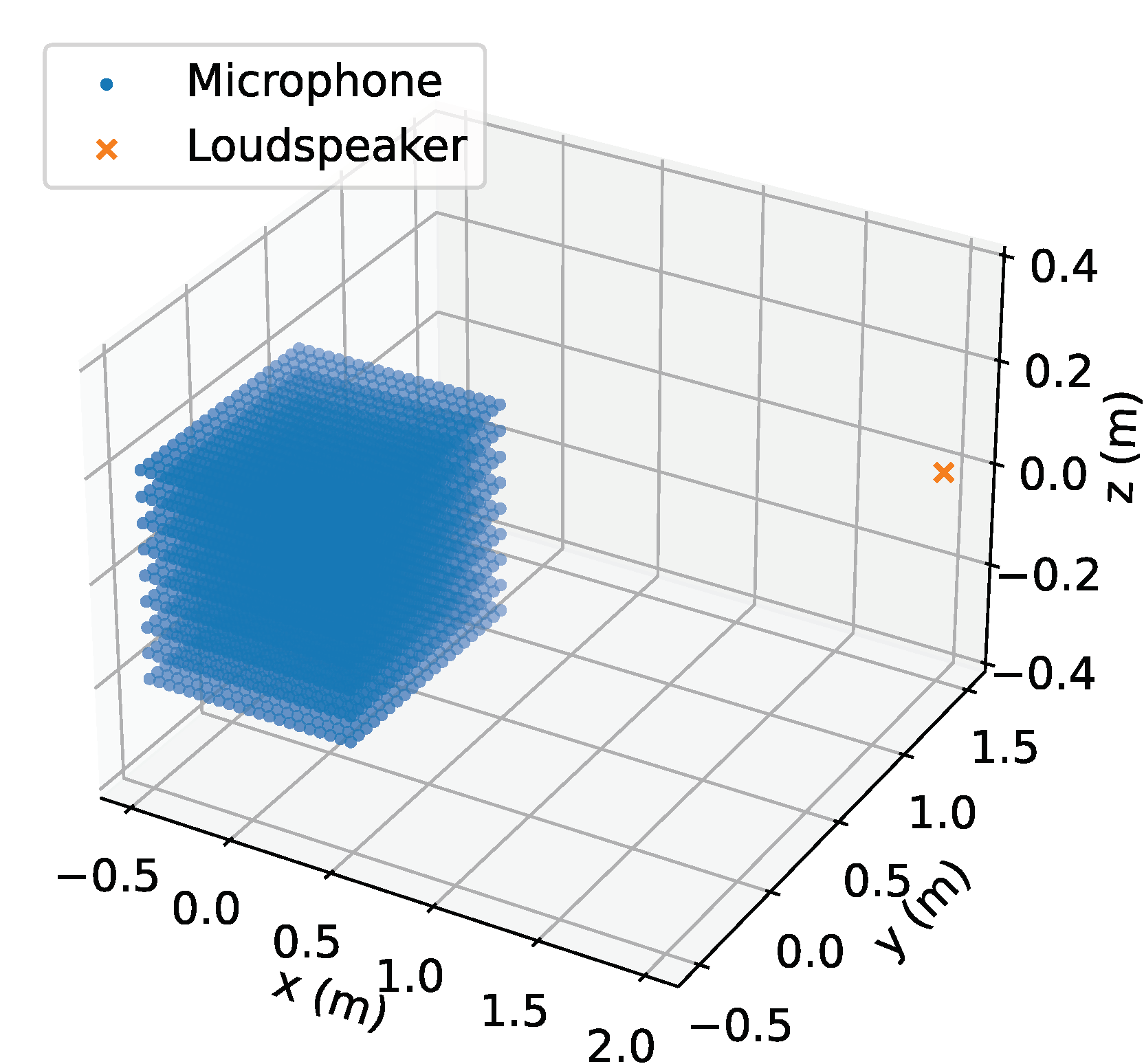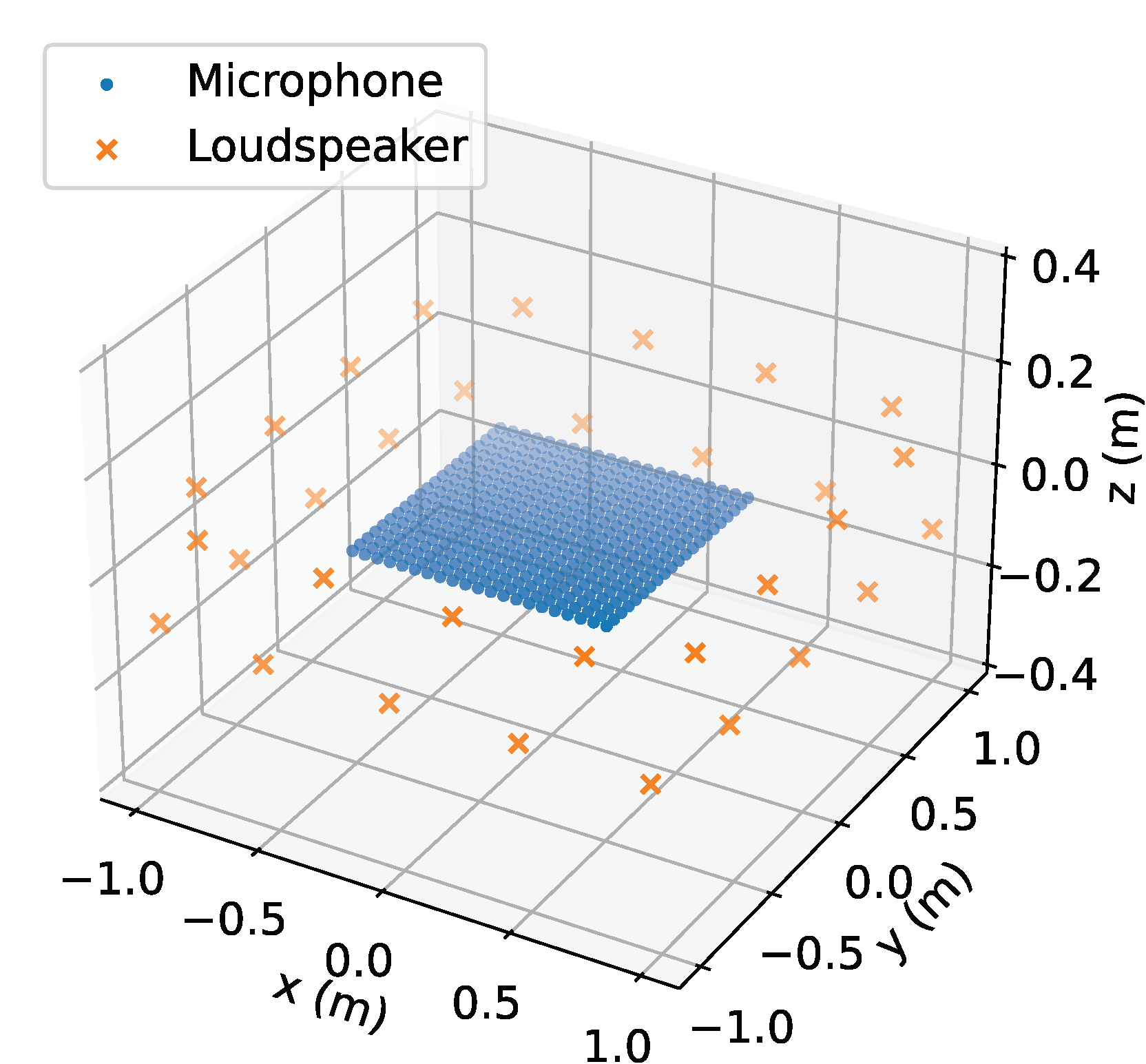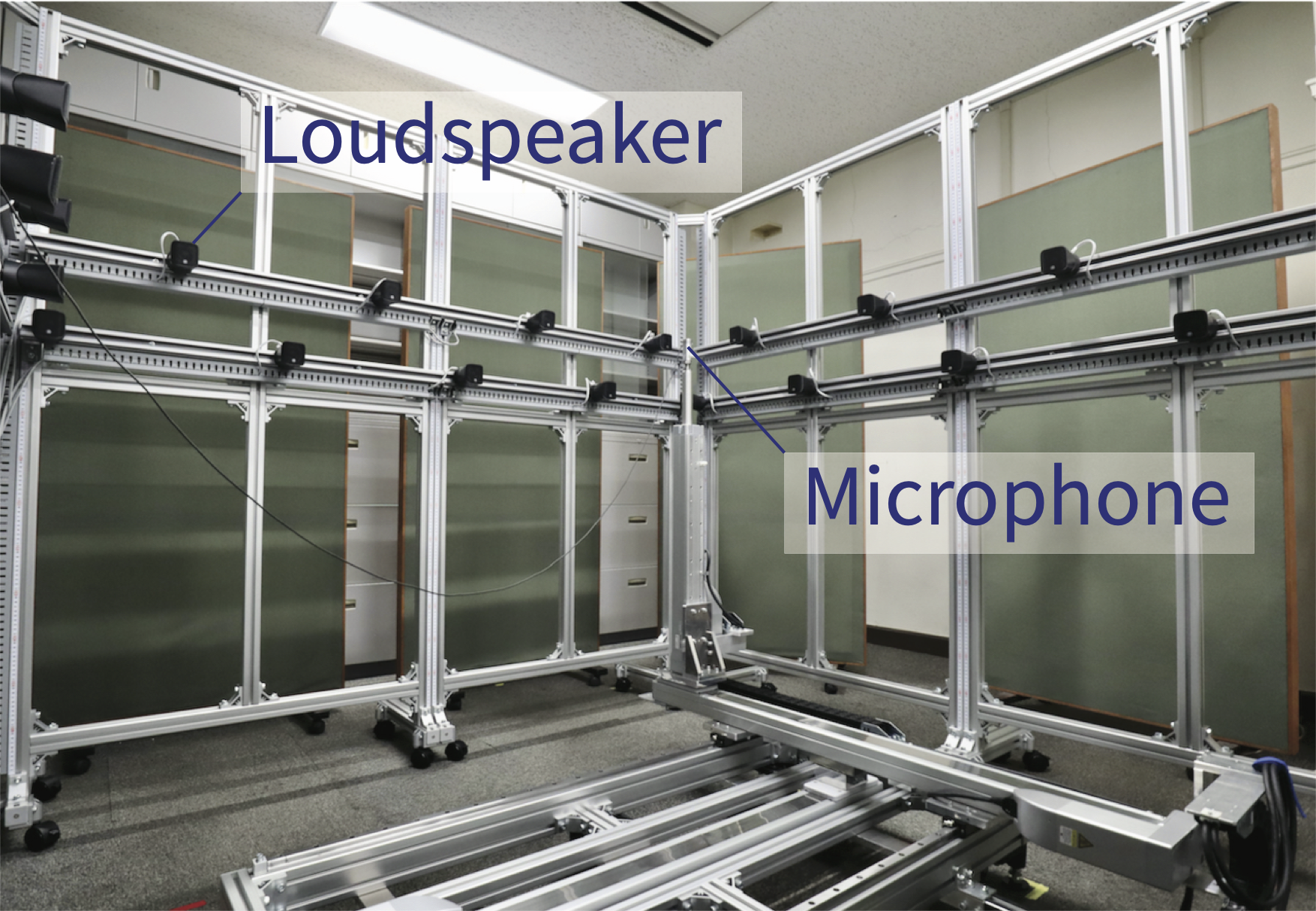About MeshRIR
MeshRIR is a dataset of acoustic room impulse responses (RIRs) at finely meshed grid points. Two subdatasets are currently available: one consists of IRs in a 3D cuboidal region from a single source, and the other consists of IRs in a 2D square region from an array of 32 sources. This dataset is suitable for evaluating sound field analysis and synthesis methods.

Download
The dataset is available in the following link:
Extract the data files in the folder “src”. For processing the IR data, see “ir_view.html” (converted from .ipynb) for Python or “ir_view.m” for Matlab. Example codes for sound field analysis and synthesis are included in the folder “example”. Latest codes are available here:
You can also try on Google Colab:
If you use the MeshRIR dataset for your research, please cite the following paper (preprint):
@inproceedings{MeshRIR,
author = "Shoichi Koyama and Tomoya Nishida and Keisuke Kimura and
Takumi Abe and Natsuki Ueno and Jesper Brunnstr\"{o}m",
title = "{MeshRIR}: A Dataset of Room Impulse Responses on Meshed Grid Points For Evaluating Sound Field Analysis and Synthesis Methods",
booktitle = "Proc. {IEEE} Int. Workshop Appl. Signal Process. Audio Acoust. (WASPAA)",
year = "2021"
}
License
The MeshRIR dataset is provided under Creative Commons Attribution 4.0 International (CC BY 4.0).
Detailed description
MeshRIR dataset consists of two subdatasets.
S1-M3969
- IRs inside a 3D cuboidal region from a single source position
S32-M441
- IRs inside a 2D square region from 32 source positions


File format
The file formats are .npy for Python (Numpy) and .mat for MATLAB. All the additional data are provided as a JSON file.
Measurement conditions
The IR at each position was measured using a Cartesian robot with an omnidirectional microphone (Primo, EM272J). The signal input and output were controlled by a PC with a Dante interface. The loudspeaker was DIATONE, DS-7 for S1-M3989 and YAMAHA, VXS1MLB for S32-M441.
| S1-M3969 | S32-M441 | |
|---|---|---|
| Sampling rate | 48000 Hz | |
| IR length | 32768 samples | |
| Room dimensions | 7.0 m × 6.4 m × 2.7 m | |
| Number of sources | 1 | 32 |
| Measurement region | 1.0 m × 1.0 m × 0.4 m | 1.0 m × 1.0 m |
| Intervals of mics | 0.05 m | |
| Number of mics | 21 × 21 × 9 points | 21 × 21 points |
| RT60 | 0.38 s | 0.19 s |
| Avg. temperature | 26.3 °C | 17.1 °C |

Usage
Basic usage examples (Python)
See ir_view.ipynb for the details.
- Import irutilities.py
import irutilities as irutil - Load microphone and source positions, and IR data
posMic, posSrc, ir = irutil.loadIR(path_to_data_folder) - Plot IR of source
srcIdxand micmicIdxirutil.irPlots(ir[srcIdx, micIdx, :], samplerate)
Basic usage examples (MATLAB)
See ir_view.m for the details.
- Add folder “matfiles” to search path
addpath('matfiles'); - Load microphone and source positions, and IR data
[posMic, posSrc, ir] = loadIR(path_to_data_folder);
Basic usage examples (Julia)
- Import irutils.jl
include("lib/utils.jl") import .utils - Load microphone and source positions, and IR data
posAll, posSrc, irAll = irutils.loadIR(path_to_data_folder)
Application examples
- Sound field reconstruction: examples/sf_reconst.ipynb
- Estimation of pressure distribution using the method proposed in [2].
- Microphone positions are selected by the MSE-based sensor placement method [3].
- Sound field control: examples/sf_control.ipynb
- Synthesis of planewave field by pressure matching.
- Weighted pressure and mode matching [4,5] are also demonstrated. Details can be found in [6].
References
- S. Koyama, T. Nishida, K. Kimura, T. Abe, N. Ueno, and J. Brunnström, “MeshRIR: A dataset of room impulse responses on meshed grid points for evaluating sound field analysis and synthesis methods,” in Proc. IEEE WASPAA, 2021. [pdf]
- N. Ueno, S. Koyama, and H. Saruwatari, “Sound field recording using distributed microphones based on harmonic analysis of infinite order,” IEEE SPL, 2018. [pdf]
- T. Nishida, N. Ueno, S. Koyama, and H. Saruwatari, “Region-restricted Sensor Placement Based on Gaussian Process for Sound Field Estimation,” IEEE Trans. SP, 2022. [pdf]
- S. Koyama and K. Arikawa, “Weighted pressure matching based on kernel interpolation for sound field reproduction,” Proc. ICA, 2022. [pdf]
- N. Ueno, S. Koyama, and H. Saruwatari, “Three-dimensional sound field reproduction based on weighted mode-matching method,” IEEE/ACM Trans. ASLP, 2019. [pdf]
- S. Koyama, K. Kimura, and N. Ueno, “Weighted pressure and mode matching for sound field reproduction: Theoretical and experimental comparisons,” J. AES, 2022. [pdf]
Author
- Shoichi Koyama (National Institute of Informatics, Tokyo, Japan)
- Tomoya Nishida
- Keisuke Kimura
- Takumi Abe
- Natsuki Ueno
- Jesper Brunnström
